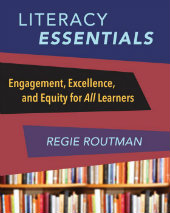10 Ways to Build the Trust Kids Need to Learn
 By Regie Routman
By Regie Routman
It’s difficult to learn from someone we don’t trust. Years ago, esteemed New Zealand educator Don Holdaway noted, “You don’t have to love every student, but you do need to bond with each one of them if they’re to learn anything at all.”
Bonding means forming meaningful and respectful connections with all students and their families—and making an effort to do the same with our colleagues.
I’ll never forget the story Don told about going in to see his daughter’s kindergarten teacher when he and his family were living and working in Cambridge, Massachusetts. His daughter was not getting along well with her teacher and felt the teacher didn’t like her. In his booming voice Don told the teacher it was her duty as his child’s teacher to bond with her.
From that day on, the trouble between teacher and child seemed to vanish, with the teacher taking Don’s command seriously. Part of that bonding meant valuing the child and sending the message: I see you, I know who you are, I understand you.
Too many of our students—and colleagues and families, too—remain invisible to us. Even if they are physically present, they are often mostly silent and unseen. Attempt to “see” through respectful eyes all members of the school community and to affirm each one of them.
Some Ways We Can Build the Bond
► Let every parent or guardian know something positive about the student. A phone call, text message, or note early on—and often, throughout the school year—serves to build trust and saves time in the long run. A parent who believes his or her child and culture are valued will be more likely to listen without feeling threatened and to cooperate when there is a problem. Bonding with families makes it easier to bond with our students.
► Let every student know we value them. Through our daily gestures, body language, and words, let’s affirm every student. It is important to let students know we are glad to see them, that their contributions to the class matter, and that we recognize their unique talents (even on days when it’s hard to do so).
Ask students, “What’s one or more important things you would like me to know about you?” Tell students, “Here are a few important things I would like you to know about me.” One thing I often tell students is: “I’m not interested in the ‘right’ answer. I’m interested in your thinking and how you got there.”
► Let every learner know we want them to succeed. As one middle school student said, “You can always tell when a teacher wants to help all students succeed.” That teacher demonstrates fairness, openness, effort, and flexibility. For example, if the whole class did badly on a test, the teacher willingly reteaches the lesson and gives a new test. As well, the teacher does quick check-ins with students to see how they are, if they understand the work, and what further support they might need.
► Greet students warmly each day, which sets a personal, caring tone. Check in with them every morning as they walk through the doors. Encourage students to wait their turn as others share quick greetings or stories as they file in. End each day in a similar manner. Even if it’s just a smile, a handshake, a fist bump, or a high five, try to connect with each student at the start and end of the day or class period. Use that opportunity to show a sense of humor, make a kind comment, have a bit of fun, and make each student feel valued.
► Get to know students, and help them get to know each other. Find appropriate ways to learn about students’ lives and interests. At the start of a class, take several minutes to ask a few volunteers to respond to such questions as “What did you do over the weekend?” and “Who learned or did something unexpected yesterday?”
Ensure students are making friends and connections with other students, not just the teacher. Incorporate small groups for learning, and change them regularly, so students get to work with most of their peers.
► Choose your language and the focus of your remarks carefully. The words we use have the power to encourage and motivate or to turn off students from even attempting a task or a requested action. Seek to first recognize and acknowledge the strengths of students. It’s easy to pass judgment on someone who disappoints us or we don’t know well. As much as possible, give students, colleagues, and families the benefit of the doubt and keep an open mind.
► Model empathy. Take time to talk with an upset student, validate all points of view, and show respect to every student through words, actions, and body language. An empathetic response to an emotional student helps to keep our learning culture positive for all students. When we embody a culture of empathy, we make our classrooms and schools safe havens for our students and families.
► Share favorite books, websites, videos, podcasts. Carefully select texts and resources to engage students, pique their curiosity and interests, and jump-start conversations where all can join in.
► Create class traditions. For example, create special class celebrations or a special song and tradition on birthdays or other celebratory days throughout the year. One teacher has her students make up their own version of the birthday song every year and often includes other languages in the song, depending on the students.
► Tell personal stories. Ordinary stories from our lives supplemented with photos of family, friends, and our special interests connect us with students and staff and show our common humanity. I always share some personal stories as a way to bond with a new group of students. (I include many such stories in my new Stenhouse book, Literacy Essentials.)
Kids are always eager to learn
Sitting side by side in a one-on-one reading conference with an older student, I began by bonding—highlighting the student’s strengths, picking a book he thought might be interesting, getting the gist of the story despite limited word-solving skills, using what he knew about the series to make predictions. Only then did we begin to discuss how and what he might work on to become a better reader.
Instead of thinking, “What’s wrong with the learner?” let’s ask, “What might I offer or do differently to ensure the student is successful?” Sometimes it just takes some compassion, honest but kind feedback, and easy-to-implement ideas to get students moving.
Kids are always eager to learn. Our job is to find a way in, and that way in depends on students and families knowing they can trust us. We must do everything we can to ensure that trusting relationships are the foundational, caring heart of our teaching and learning.
Without high trust, without building the bond, nothing of consequence regarding engagement, excellence, or equity will be possible. With that trust, the possibilities for what we can accomplish are endless.









































This post makes me so happy. Making sure kiddos know they are valuable, believed in, and will be supported as they learn and grow is the bottom line in teaching. Regie, bless your heart for always bringing the conversation back to this bottom line.
Love this, Regie . . . especially the idea of letting both parents and students know that we value them. The whole post is valuable!
While I understand and agree with you that forming bonds with our students is important, I do not care for your story about Mr. Holdaway who in his “booming voice…told the teacher it was her duty to bond with [his child].” You go on to say that the trouble seemed to “vanish” from that point on. This sounds like bullying to me. The teacher probably bent over backward to make sure Mr. Holdaway never had a reason to use his “booming voice” with her again. If a parent wants to respectfully voice his concerns with me as a professional, I am more than willing to listen and seek a solution to the problem. However, I resent nothing more as an educator than to be “commanded” by a parent to do my job differently, no matter how “esteemed” that parent may be. Perhaps I have misunderstood and need more information to fully understand the story; however, it seems to me that Mr. Holdaway needs to “see” through more “respectful” eyes himself.
That was an especially salient point about choosing your words and remarks. At first glance it seems like a small thing, but students can latch on to throw away comments by the teacher and it can effect that relationship and the dynamics of the class to boot.